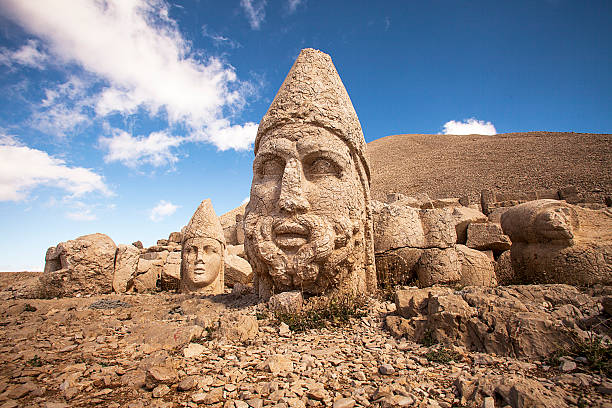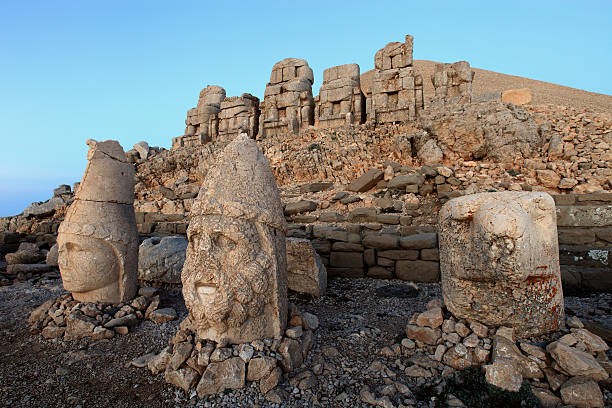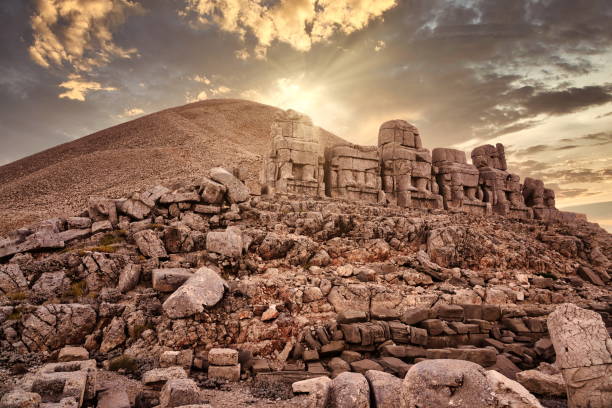Mount Nemrut: Unveiling Turkey’s Ancient UNESCO-Heritage Majesty of Gods, Kings, Mythic Sculptures, and Eternal, Perpetual Mysteries
Nestled in the southeastern part of Turkey, within the rugged landscapes of the Anti-Taurus Mountains, Mount Nemrut stands as one of the most enigmatic and awe-inspiring historical sites in the world. Rising to an elevation of 2,134 meters (7,001 feet) above sea level, this mountain is not just a natural wonder but also a monumental testament to the grandeur of ancient civilizations. The summit of Mount Nemrut is home to the famous sanctuary and tomb of King Antiochus I of Commagene, a ruler who sought to bridge the gap between humanity and divinity.

The site, with its colossal stone statues, intricate reliefs, and a mysterious tomb, has captivated archaeologists, historians, and travelers for centuries. Recognized as a UNESCO World Heritage Site in 1987, Mount Nemrut continues to be a symbol of cultural synthesis, where Greek, Persian, and Anatolian traditions merge in a breathtaking open-air museum.
Historical Background of Mount Nemrut
The history of Mount Nemrut is deeply intertwined with the Kingdom of Commagene, a small but influential Hellenistic state that thrived between the 1st century BC and the 1st century AD. Commagene was situated at the crossroads of major civilizations, including the Roman Empire to the west and the Parthian Empire to the east. King Antiochus I Theos, who ruled from 70 to 36 BC, was a visionary monarch who sought to create a divine legacy for himself. He claimed descent from both Greek and Persian royalty, styling himself as a god-king who would mediate between the mortal world and the heavens. To immortalize his divine status, Antiochus commissioned the construction of a grand hierothesion (a sacred burial site) atop Mount Nemrut, transforming the mountain into a religious and cultural sanctuary.
The site was designed to serve as both a tomb and a place of worship, where rituals honoring the gods and the deified king could be performed. Antiochus envisioned his sanctuary as a meeting point between the celestial and earthly realms, a place where his soul would ascend to join the gods after his death. The mountain’s remote and elevated location was deliberately chosen to symbolize proximity to the heavens. Despite its grandeur, the kingdom of Commagene eventually fell under Roman domination, and the sanctuary was abandoned, left to the mercy of time and nature. For centuries, the statues and inscriptions lay buried under layers of earth until their rediscovery in the late 19th century by European archaeologists.

The Monumental Statues and Architectural Layout
The most striking feature of Mount Nemrut is undoubtedly the colossal statues that adorn its summit. These towering figures, each standing approximately 8-10 meters (26-33 feet) tall, represent a syncretic pantheon of Greek, Persian, and Armenian deities, alongside the deified King Antiochus himself. The statues are arranged in two main terraces—the East Terrace and the West Terrace—flanking a central tumulus believed to be the burial mound of Antiochus. The East Terrace is the more elaborate of the two, featuring a row of seated gods with the king among them. The deities include Zeus-Oromasdes (a fusion of the Greek Zeus and the Persian Ahura Mazda), Apollo-Mithras (combining Greek Apollo with the Persian sun god Mithras), Hercules-Artagnes (a blend of Greek Hercules and the Persian god Verethragna), and the goddess Commagene, personifying the kingdom itself.
Each statue was originally seated on thrones, their heads adorned with crowns or diadems, symbolizing their divine authority. Over time, the heads have toppled from their bodies due to earthquakes and erosion, creating the surreal spectacle of giant stone heads scattered across the terraces. Despite their dislodged state, the statues retain an eerie majesty, their finely carved features reflecting the artistic mastery of their creators. The West Terrace, though similar in design, is less well-preserved and includes a series of reliefs depicting Antiochus shaking hands with the gods, a symbolic gesture of his divine kinship.
The central tumulus, rising 50 meters (164 feet) high and composed of small limestone fragments, has never been fully excavated, leaving the actual burial chamber of Antiochus a mystery. Archaeologists speculate that the tomb, if it exists, would contain treasures and artifacts akin to those found in other royal burial sites of the period. However, the artificial mound has resisted penetration, and any attempts to excavate it could risk destabilizing the entire structure. The tumulus adds an air of mystique to Mount Nemrut, fueling legends and theories about hidden chambers and lost relics beneath its rocky surface.
Religious and Cultural Significance
Mount Nemrut is more than just an ancient burial site; it is a profound expression of religious syncretism and political propaganda. Antiochus I’s reign was marked by a deliberate blending of cultures, as he sought to unify his ethnically diverse kingdom under a shared religious identity. The deities represented on the mountain are not purely Greek or Persian but rather hybrid figures that reflect the multicultural ethos of Commagene. This fusion was a strategic move to appeal to both Hellenistic and Persian subjects, reinforcing the king’s authority as a divine mediator.

The sanctuary also served as a stage for elaborate religious ceremonies, particularly during the king’s birthday and coronation anniversary. According to inscriptions found at the site, priests and worshippers would gather at the summit to perform rituals, including feasts and libations, to honor the gods and the deified king. The East Terrace’s altar and processional way suggest that these ceremonies were grand public spectacles, designed to reinforce the cult of Antiochus as a living god. The religious significance of Mount Nemrut extended beyond Commagene, as it became a pilgrimage site for neighboring regions, further enhancing the king’s prestige.
Rediscovery and Modern Exploration
For centuries, Mount Nemrut remained forgotten, its statues buried under layers of soil and debris. The site’s rediscovery in 1881 by Karl Sester, a German engineer working on Ottoman road construction, brought it back into the spotlight. Sester’s reports attracted the attention of European archaeologists, leading to subsequent expeditions by Otto Puchstein and Karl Humann in the late 19th century. These early explorers documented the statues and inscriptions, laying the groundwork for future research.
Systematic archaeological studies began in the mid-20th century, with teams from the United States and Turkey conducting extensive surveys and restoration efforts. The American archaeologist Theresa Goell dedicated decades to studying Mount Nemrut, producing detailed records of its art and architecture. Modern technologies, such as 3D scanning and ground-penetrating radar, have since been employed to map the site and explore the hidden chambers within the tumulus, though many mysteries remain unsolved.
Visiting Mount Nemrut: A Traveler’s Experience
Today, Mount Nemrut is one of Turkey’s most iconic tourist destinations, drawing visitors from around the world. The journey to the summit is an adventure in itself, requiring a steep climb or a drive along winding mountain roads. Most travelers opt to visit at sunrise or sunset, when the golden light bathes the statues in an ethereal glow, creating a mesmerizing atmosphere. The East Terrace, with its scattered heads and panoramic views, is the highlight of the visit, offering unparalleled photo opportunities.
Nearby attractions include the ancient city of Arsameia, the summer capital of Commagene, and the Roman-era Cendere Bridge. The region’s rich history and stunning landscapes make it a must-visit for history enthusiasts and nature lovers alike. Efforts to preserve Mount Nemrut continue, with ongoing restoration projects aimed at protecting the fragile statues from further erosion and seismic activity.
Conclusion: The Eternal Legacy of Mount Nemrut
Mount Nemrut stands as a timeless monument to human ambition, artistic brilliance, and spiritual yearning. It is a place where history, mythology, and nature converge, offering a glimpse into the mind of a king who sought immortality through stone and legend. The mountain’s colossal statues, though weathered by time, still command reverence, their silent gaze a reminder of a bygone era when gods and kings walked the earth together. As a UNESCO World Heritage Site, Mount Nemrut is not just a treasure of Turkey but a legacy for all humanity, a symbol of our enduring quest to transcend the boundaries of mortality and leave an indelible mark on the world.
Photo from: iStock
0 Comment to "Mount Nemrut: Turkey’s Majestic UNESCO World Heritage Site Honoring Legendary Ancient Gods, Kings, and Timeless Mysteries"
Post a Comment